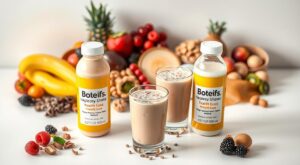Imagine waking up every day feeling full of energy. No more worrying about your blood sugar levels. This dream can become a reality when you manage your type 2 diabetes through diet. This plan focuses on real, nutritious foods that help keep your blood sugar stable and improve your health.
Dietary changes can greatly help manage diabetes, but it can feel overwhelming. You’re not alone in this fight. Many have found that eating wholesome foods can help manage and even reverse diabetes symptoms. It’s time to learn how nourishing foods can help you regain your health and energy.
Understanding Type 2 Diabetes
First, let’s understand what type 2 diabetes is. It happens when your body doesn’t use insulin well or doesn’t make enough. This makes your blood sugar levels go up. Millions of Americans deal with this, showing we need to know more about it.
Not treating diabetes can cause serious health problems. These include heart disease, kidney damage, and nerve issues. Keeping an eye on your blood sugar is key. With 1 in 10 adults in the U.S. having it, managing it is very important.
Learning about type 2 diabetes helps you take care of your health. By being proactive, you can improve your life and health a lot.
For more on managing type 2 diabetes, check out this resource. It can help guide you on your journey.
Importance of a Diabetes Diet
Understanding the importance of a diabetic diet is key for managing blood sugar levels. A well-planned diet can greatly improve your health. It helps you feel better and maintain a healthy weight.
Healthy eating for diabetes means balanced meals with essential nutrients. This approach helps avoid blood sugar spikes. It’s about making choices that help manage diabetes symptoms and reduce risks.
By choosing the right foods, you can create a lasting meal plan. This plan meets your dietary needs and supports a healthy lifestyle. It’s about making smart choices for a healthier future.
| Food Group | Examples | Benefits |
|---|---|---|
| Vegetables | Spinach, broccoli, peppers | Low in calories, high in vitamins and minerals |
| Whole Grains | Quinoa, brown rice, oats | Rich in fiber, helps regulate blood sugar levels |
| Proteins | Chicken, fish, legumes | Supports muscle health and keeps you full longer |
| Healthy Fats | Avocado, nuts, olive oil | Helps to reduce inflammation and keeps cells healthy |
Science-Based Nutrition Recommendations
The American Diabetes Association says there’s no one-size-fits-all diet for diabetes. It’s important to tailor your nutrition to your own needs. Following science-based guidelines helps you get the nutrients you need while keeping your blood sugar in check.
The Nutrition Consensus Report lists several effective meal patterns. These patterns fit different tastes and cultures, making it easier to choose what you eat. They focus on *whole foods*, lean proteins, and fiber-rich foods. These choices help improve your health and manage your diabetes.
Watching how your body reacts to different foods can help you make better choices. Getting advice from a registered dietitian or nutritionist can also be very helpful. They can give you personalized tips to fit your lifestyle and needs.
| Food Group | Examples | Benefits |
|---|---|---|
| Whole Grains | Oats, quinoa, brown rice | Rich in fiber, helps regulate blood sugar |
| Lean Proteins | Chicken, fish, legumes | Supports muscle maintenance, keeps you full |
| Healthy Fats | Avocado, nuts, olive oil | Anti-inflammatory properties, improve heart health |
| Non-Starchy Vegetables | Spinach, broccoli, peppers | Low in calories, high in nutrients |
Key Elements of a Type 2 Diabetes Diet Plan
Creating a good type 2 diabetes diet plan means knowing the key parts of balanced nutrition. It focuses on healthy carbs, proteins, and fats. This makes sure your meals are both good for you and tasty.
Choosing whole, aged foods helps control blood sugar better. Also, picking unprocessed foods is best for their nutrients.
Controlling how much you eat is very important. It stops blood sugar from rising too high. Eating at the same times every day also helps manage blood sugar.
Here are key parts of a diabetes-friendly diet to keep you healthy:
- Whole grains like brown rice and quinoa for energy and fiber.
- Lean proteins such as chicken and fish to help build muscle.
- Healthy fats like avocados and nuts for heart health.
- Non-starchy vegetables to increase vitamins and minerals without excess carbohydrates.
Knowing these elements helps you make meals that taste great and are good for you. A balanced diet and mindful eating habits help you manage your diabetes well.
Benefits of Real Foods in Managing Blood Sugar
Switching to real, whole foods can greatly help manage blood sugar levels. Whole foods offer more than just nutrition; they bring many health benefits. They are packed with vitamins, minerals, and antioxidants that processed foods often lack.
By choosing whole foods, you can lead a healthier lifestyle. This lifestyle supports better metabolic function. It’s a key step in managing diabetes effectively.
Studies reveal that whole foods can lower inflammation. This is vital for better heart health. Foods like fruits, vegetables, legumes, and whole grains have lower glycemic indices. This means they help keep blood sugar levels stable.
They also improve insulin sensitivity and metabolic health. This is great news for those with diabetes.
Here’s a table comparing whole foods and processed foods:
| Food Type | Nutritional Value | Glycemic Index | Health Benefits |
|---|---|---|---|
| Whole Foods (e.g., brown rice, broccoli) | High in vitamins, minerals, and fiber | Low to moderate | Reduces inflammation, improves heart health |
| Processed Foods (e.g., white rice, fries) | Low in nutrients, often high in sugars | High | Increases inflammation, negatively impacts heart health |
Adding whole foods to your diet has many benefits. It’s not just about managing blood sugar. It’s about improving your overall health and making better food choices.
Choosing whole foods empowers you to manage your diabetes better. Experience the positive effects on your health journey.
Best Foods for Type 2 Diabetes
Choosing the right foods is key for managing type 2 diabetes. Focus on fruits, vegetables, whole grains, and healthy fats. These foods help keep blood sugar levels in check and support your health.
Fruits and Vegetables
Fruits and vegetables are essential in your diet. They’re packed with vitamins, minerals, and fiber. This makes them great for your health without raising blood sugar too much. Some top picks include:
- Berries (strawberries, blueberries, raspberries)
- Leafy greens (spinach, kale, Swiss chard)
- Cruciferous vegetables (broccoli, cauliflower, Brussels sprouts)
- Citrus fruits (oranges, grapefruits, lemons)
Adding these to your meals can help you make healthy food choices for diabetes.
Whole Grains
Whole grains are good for stable blood sugar. Choose grains high in fiber for better digestion. Some great options are:
- Quinoa
- Brown rice
- Barley
- Oats
These grains are not only healthy but also great for type 2 diabetes.
Healthy Fats
Healthy fats are good for your heart and keep you full. Look for foods rich in omega-3s and monounsaturated fats. Some good choices are:
- Avocados
- Nuts (walnuts, almonds, pistachios)
- Seeds (chia seeds, flaxseeds)
- Olive oil and canola oil for cooking
These foods are good for your overall health. They should be part of your daily meals as you follow the best foods for type 2 diabetes.

Meal Planning Strategies for Type 2 Diabetes
Planning your meals is key to managing diabetes and keeping your diet balanced. Being organized and knowing how to cook can really help control your blood sugar. Using the Diabetes Plate method is a great way to make sure your meals are both healthy and balanced.
Creating a Balanced Plate
The Diabetes Plate method helps you divide your plate into sections for better nutrition. Put half of your plate with non-starchy veggies like spinach, broccoli, and peppers. Use a quarter for lean proteins like chicken, fish, or beans, and the last quarter for whole grains like quinoa or brown rice. This way, you can make meals that help keep your blood sugar in check.
Strategies for Portion Control
Controlling your portions is critical for diabetes meal planning. Paying attention to how much you eat can stop you from eating too much, which can raise your blood sugar. Here are some tips:
- Use smaller plates to naturally limit portion sizes.
- Measure out serving sizes instead of eating directly from large containers.
- Practice mindful eating by savoring your food and avoiding distractions while you eat.
- Schedule regular meal times to support your insulin effectiveness and help regulate hunger cues.
Low Carb Diet for Type 2 Diabetes
Knowing how carbs affect your diet is key when managing type 2 diabetes. Carbs can greatly impact your blood sugar levels. It’s important to pick the right foods to avoid spikes in blood sugar.
Understanding Carbohydrates and Blood Sugar
Carbs come in simple and complex types. Simple carbs, like those in sugary snacks, raise blood sugar quickly. Complex carbs, in foods like veggies and whole grains, release glucose slowly. Choosing low-carb foods helps keep blood sugar stable and improves health.
Best Low-Carb Foods
Choosing the right low-carb foods is essential. Here are some top picks:
- Leafy Greens: Spinach, kale, and lettuce are low in carbs and full of nutrients.
- Nuts and Seeds: Almonds, walnuts, chia seeds, and flaxseeds offer healthy fats and fiber.
- Cruciferous Vegetables: Broccoli, cauliflower, and Brussels sprouts are great for low-carb diets.
- Avocado: Rich in healthy fats, avocados have very low carbs.
- Berries: Strawberries, raspberries, and blackberries have less sugar than other fruits.
Following a low carb diet for type 2 diabetes means tracking carbs. Reading labels, keeping a food journal, or using apps can help. Managing carbs well can greatly improve blood sugar control and health.

Healthy Eating for Type 2 Diabetes
Managing type 2 diabetes starts with what you eat. Eating foods high in fiber is key. These foods help control blood sugar levels.
Focus on Fiber-Rich Foods
Foods high in fiber are great for blood sugar control. They slow down sugar absorption, preventing blood sugar spikes. Adding fiber to your diet improves digestion and keeps you full, helping you stay at a healthy weight. Here are some fiber-rich foods and their benefits:
| Food | Fiber Content (per serving) | Benefits |
|---|---|---|
| Black Beans | 15g | High in protein and helps stabilize blood sugar levels |
| Chia Seeds | 10g | Rich in omega-3s and promotes satiety |
| Brussels Sprouts | 4g | Supports digestive health and lowers cholesterol |
| Oats | 4g | Provides lasting energy and reduces the risk of diabetes complications |
Importance of Healthy Proteins
Healthy proteins are also vital for balanced meals. Legumes, fish, and lean meats are good for you. They help manage hunger and keep blood sugar stable. Choosing healthier proteins can greatly improve your diet and help manage diabetes over time.
Diabetic Meal Plan Examples
A good diabetic meal plan helps control blood sugar. Here are meal examples for a week. They include breakfast, lunch, dinner, and snacks. These options are healthy for those with diabetes.
Sample Menus for a Week
| Day | Breakfast | Lunch | Dinner |
|---|---|---|---|
| Monday | Oatmeal with berries | Grilled chicken salad | Baked salmon with steamed broccoli |
| Tuesday | Greek yogurt topped with nuts | Turkey wrap with whole grain tortilla | Stir-fried tofu with mixed vegetables |
| Wednesday | Scrambled eggs with spinach | Quinoa salad with chickpeas | Grilled shrimp with brown rice |
| Thursday | Whole grain toast with avocado | Vegetable soup with a side salad | Baked chicken thighs with sweet potatoes |
| Friday | Chia pudding with almond milk | Fruit and nut salad | Stuffed bell peppers with ground turkey |
| Saturday | Smoothie with spinach and protein powder | Grilled vegetable sandwich | Zucchini noodles with marinara sauce |
| Sunday | Pancakes made with almond flour | Fish tacos with cabbage slaw | Roasted pork with asparagus |
Snack Ideas and Portion Sizes
- Celery sticks with almond butter (2 tablespoons)
- Cottage cheese (½ cup) with sliced peaches
- Hummus (3 tablespoons) with carrot sticks
- Handful of mixed nuts (1 ounce)
- Apple with a slice of cheese

Using the Diabetes Plate Method
The diabetes plate method is a simple way to plan meals for diabetes. It divides your plate into sections for a balanced meal. Imagine drawing lines on your plate for each food group.
Start by filling half of your plate with non-starchy vegetables. Choose items like broccoli, spinach, or bell peppers. These are low in carbs and rich in vitamins and minerals, helping control blood sugar.
Then, use a quarter for lean proteins like chicken, fish, or legumes. These keep you full and satisfied, key for managing diabetes. The last quarter is for whole grains or starchy veggies, like brown rice or sweet potatoes. This balances carbs and prevents blood sugar spikes.
Using the diabetes plate method helps you make better food choices. It also helps you keep track of portion sizes. This visual guide empowers you to make healthier choices at every meal.
Superstar Foods for Type 2 Diabetes
Adding superstar foods to your diet can greatly improve your health if you have type 2 diabetes. These foods help keep your blood sugar stable and give you important nutrients. Eating non-starchy vegetables, legumes, and heart-healthy fish is key to a better diet and health.
Non-Starchy Vegetables
Non-starchy vegetables are top picks for managing diabetes. They’re low in calories and carbs but full of vitamins and minerals. Some great options are:
- Spinach
- Broccoli
- Cauliflower
- Bell Peppers
You can add these veggies to salads, stir-fries, and soups. They add flavor and help keep your blood sugar stable.
Legumes and Beans
Legumes and beans are packed with protein and fiber, making them great for diabetes. They help you feel full and control your blood sugar. Some favorites include:
- Black Beans
- Lentils
- Chickpeas
- Pinto Beans
Adding these to your meals, like in salads or stews, boosts your nutrient intake and supports a balanced diet.
Heart-Healthy Fish Options
Heart-healthy fish are rich in omega-3 fatty acids, which are good for your heart. Some great choices are:
- Salmon
- sardines
- trout
- mackerel
You can grill, bake, or add them to salads. They’re tasty and good for managing diabetes.

By adding these superstar foods to your meals, you not only keep your blood sugar stable. You also move towards a healthier lifestyle.
Creating Your Own Type 2 Diabetes Nutrition Plan
Creating a personal diabetes nutrition plan is key to managing your health. Think about your food likes, lifestyle, and health goals. This way, you make a plan that you can follow easily.
Start by making a list of your favorite and least favorite foods. This will be the base of your diabetes diet. Choose foods that taste good and meet your nutritional needs. Consider how much time you have for cooking and your grocery budget.
Plan your meals for the week, focusing on foods you love. Try to include whole, unprocessed foods and avoid sugary snacks. For ideas, look at this meal plan for prediabetes reversal.
Keep adjusting your plan based on how your body reacts. Watch how your meals affect your blood sugar levels. This will help you refine your plan. Remember, it’s not just about diabetes; it’s about feeling your best too.
Consulting with a Dietitian
Getting diabetes dietitian advice is key to managing your diabetes well. A registered dietitian creates meal plans that fit your health needs, likes, and lifestyle. They help you make a nutrition plan that keeps your blood sugar in check.
The importance of dietitian for diabetes is clear. They give advice based on the latest research. They help you change your diet to match new findings. This means they help you pick the right foods and amounts for your health.
Here’s a table showing how dietitians can help in different ways:
| Area of Support | Description |
|---|---|
| Meal Planning | Crafting meal plans tailored to individual dietary preferences and needs. |
| Portion Control | Guiding you on portion sizes to maintain optimal blood sugar levels. |
| Nutritional Education | Teaching you about food groups and their impact on glucose levels. |
| Lifestyle Modifications | Integrating dietary changes with physical activity and overall wellness. |
| Monitoring Strategies | Advising on how to monitor your blood sugar effectively as dietary changes take effect. |
Monitoring Blood Sugar Levels with Diet Changes
It’s key to understand how to check blood sugar levels when you change your diet. Everyone’s body reacts differently to food. So, it’s important to watch how your blood sugar changes with certain meals.
This helps you make better choices about what you eat. You can see how different foods affect your blood sugar. This way, you can pick foods that keep your blood sugar stable.
Keeping a food diary can be very helpful. Write down what you eat and your blood sugar levels. This helps you spot patterns and make better food choices.
Talking to your healthcare team is also important. They can give you diet plans that fit your needs. This way, you can manage your diabetes better and feel more confident about your health.
Conclusion
Managing type 2 diabetes well means having a thoughtful diet plan. This type 2 diabetes diet summary offers key insights. It helps you control your health with balanced meals and smart food picks.
Choosing whole foods and knowing their blood sugar effects is key. Healthy eating for diabetes is a long-term lifestyle choice. It’s not just about quick fixes.
By following the tips in this article, you can improve your health. Focus on high-quality proteins, healthy fats, and fiber. Also, get help from a healthcare expert to fit your diet to your needs.
Let motivation guide you to make healthier choices. Every small step can make a big difference. Start today for a healthier tomorrow!















One Response